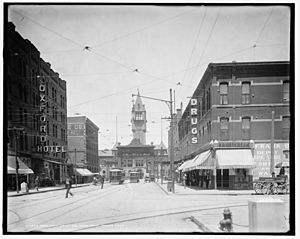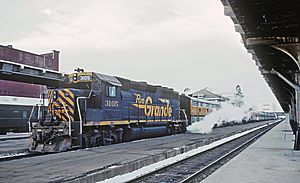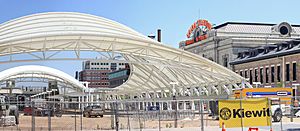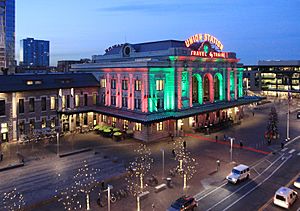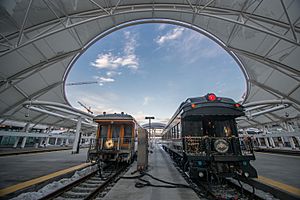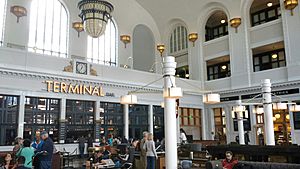Denver Union Station facts for kids
Quick facts for kids
Denver Union Station
|
||||||||||||||||||||||||||||||||||||||||||||||||||||||||||||||||||||||||||||||||||||||||||||||
|---|---|---|---|---|---|---|---|---|---|---|---|---|---|---|---|---|---|---|---|---|---|---|---|---|---|---|---|---|---|---|---|---|---|---|---|---|---|---|---|---|---|---|---|---|---|---|---|---|---|---|---|---|---|---|---|---|---|---|---|---|---|---|---|---|---|---|---|---|---|---|---|---|---|---|---|---|---|---|---|---|---|---|---|---|---|---|---|---|---|---|---|---|---|---|
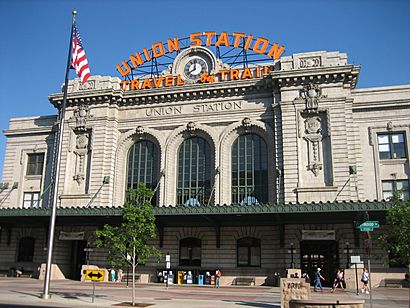
Front of historic station building, facing Wynkoop St.
|
||||||||||||||||||||||||||||||||||||||||||||||||||||||||||||||||||||||||||||||||||||||||||||||
| Location | 1701 Wynkoop Street 1600 Wewatta Street (RTD light rail) Denver, Colorado, U.S. |
|||||||||||||||||||||||||||||||||||||||||||||||||||||||||||||||||||||||||||||||||||||||||||||
| Coordinates | 39°45′11″N 105°00′00″W / 39.75306°N 105.00000°W | |||||||||||||||||||||||||||||||||||||||||||||||||||||||||||||||||||||||||||||||||||||||||||||
| Owned by | RTD and partners | |||||||||||||||||||||||||||||||||||||||||||||||||||||||||||||||||||||||||||||||||||||||||||||
| Platforms | 2 side platforms, 3 island platforms (commuter rail and Amtrak) 1 side platform, 1 island platform (light rail) |
|||||||||||||||||||||||||||||||||||||||||||||||||||||||||||||||||||||||||||||||||||||||||||||
| Tracks | 8 (commuter rail and Amtrak) 3 (light rail) |
|||||||||||||||||||||||||||||||||||||||||||||||||||||||||||||||||||||||||||||||||||||||||||||
| Bus stands | 22 | |||||||||||||||||||||||||||||||||||||||||||||||||||||||||||||||||||||||||||||||||||||||||||||
| Connections | Thruway Motorcoach Regional highway coaches |
|||||||||||||||||||||||||||||||||||||||||||||||||||||||||||||||||||||||||||||||||||||||||||||
| Construction | ||||||||||||||||||||||||||||||||||||||||||||||||||||||||||||||||||||||||||||||||||||||||||||||
| Disabled access | Yes | |||||||||||||||||||||||||||||||||||||||||||||||||||||||||||||||||||||||||||||||||||||||||||||
| Other information | ||||||||||||||||||||||||||||||||||||||||||||||||||||||||||||||||||||||||||||||||||||||||||||||
| Station code | Amtrak code: DEN | |||||||||||||||||||||||||||||||||||||||||||||||||||||||||||||||||||||||||||||||||||||||||||||
| History | ||||||||||||||||||||||||||||||||||||||||||||||||||||||||||||||||||||||||||||||||||||||||||||||
| Opened | 1881 | |||||||||||||||||||||||||||||||||||||||||||||||||||||||||||||||||||||||||||||||||||||||||||||
| Rebuilt | 1914, 2010–2014 | |||||||||||||||||||||||||||||||||||||||||||||||||||||||||||||||||||||||||||||||||||||||||||||
| Traffic | ||||||||||||||||||||||||||||||||||||||||||||||||||||||||||||||||||||||||||||||||||||||||||||||
| Passengers (FY2018) | 143,986 |
|||||||||||||||||||||||||||||||||||||||||||||||||||||||||||||||||||||||||||||||||||||||||||||
| Passengers (2019) | 37,531 (Average weekday) (RTD Rail) | |||||||||||||||||||||||||||||||||||||||||||||||||||||||||||||||||||||||||||||||||||||||||||||
| Services | ||||||||||||||||||||||||||||||||||||||||||||||||||||||||||||||||||||||||||||||||||||||||||||||
|
||||||||||||||||||||||||||||||||||||||||||||||||||||||||||||||||||||||||||||||||||||||||||||||
|
||||||||||||||||||||||||||||||||||||||||||||||||||||||||||||||||||||||||||||||||||||||||||||||
|
Union Station
|
||||||||||||||||||||||||||||||||||||||||||||||||||||||||||||||||||||||||||||||||||||||||||||||
| Lua error in Module:Location_map at line 420: attempt to index field 'wikibase' (a nil value). | ||||||||||||||||||||||||||||||||||||||||||||||||||||||||||||||||||||||||||||||||||||||||||||||
| Location | 17th St. at Wynkoop, Denver, Colorado | |||||||||||||||||||||||||||||||||||||||||||||||||||||||||||||||||||||||||||||||||||||||||||||
| Area | 25.1 acres (10.2 ha) | |||||||||||||||||||||||||||||||||||||||||||||||||||||||||||||||||||||||||||||||||||||||||||||
| Built | 1881 | |||||||||||||||||||||||||||||||||||||||||||||||||||||||||||||||||||||||||||||||||||||||||||||
| Architect | Taylor, A.; Fairfield & Burton | |||||||||||||||||||||||||||||||||||||||||||||||||||||||||||||||||||||||||||||||||||||||||||||
| Architectural style | Beaux-Arts, Classical Revival, Romanesque Revival | |||||||||||||||||||||||||||||||||||||||||||||||||||||||||||||||||||||||||||||||||||||||||||||
| NRHP reference No. | 74000571 | |||||||||||||||||||||||||||||||||||||||||||||||||||||||||||||||||||||||||||||||||||||||||||||
| Added to NRHP | November 20, 1974 | |||||||||||||||||||||||||||||||||||||||||||||||||||||||||||||||||||||||||||||||||||||||||||||
Denver Union Station is a major train station and central transportation spot in Denver, Colorado. It's located at 17th and Wynkoop Streets in the LoDo area. The station includes a historic building, a train shed, an underground bus area with 22 gates, and a light rail station.
The first station opened here on June 1, 1881. However, it burned down in 1894. The building you see today was built in two parts, with the main central section finished in 1914.
In 2012, the station got a huge makeover. It became the center of a new area with homes, shops, and businesses built on the old train yards. The main station building reopened in summer 2014. It now has the 112-room Crawford Hotel, several restaurants, shops, and a large train hall.
Contents
Denver Union Station: A Hub of History and Travel
The Station's Early Days
Denver's first train station was built in 1868. It served the new Denver Pacific Railway, which connected Denver to the main transcontinental train line in Cheyenne, Wyoming. By 1875, Denver had four different train stations. This made it hard for passengers to switch between different train lines.
To fix this, the Union Pacific Railroad suggested building one main "Union Station." This station would bring all the different train operations together. In February 1880, the owners of four major train lines agreed to build a station. It would be located at 17th and Wynkoop Streets. The station opened in May 1881.
In 1894, a fire started in the women's restroom. It destroyed the middle part of the 1881 station. A new design was created for a bigger station. Both the 1881 and 1894 stations had a tall central clock tower.
A New Look for a New Century
On July 4, 1906, a large arch was put up in front of the station. It was meant to be a special entrance for people coming to and leaving Denver. The arch cost $22,500 and used 70 tons of steel. It had over 2,000 light bulbs.
The arch first said "Welcome" on both sides. Later, the side facing 17th Street was changed to "Mizpah." This is a Hebrew word that means a strong connection between people who are separated. It was used as a farewell to people leaving Denver.
In 1912, the original group that owned Union Depot changed. A new company, the Denver Terminal Railway Company, took over. This new group decided to tear down and rebuild the central part of the station. This was because more and more passengers were using it. The new central part opened in 1914. It was designed in the Beaux-Arts style.
By the 1920s and 1930s, over 80 trains used the station every day. Important people like Queen Marie of Romania and Presidents Theodore Roosevelt, William Howard Taft, and Franklin Delano Roosevelt arrived in Denver through this station. Because of the growing traffic, the Mizpah Arch was seen as a danger. It was taken down in 1931.
Travel Changes Over Time
During World War II, train travel became very popular. However, in the second half of the 20th century, fewer people used trains. Cars and airplanes became more common. This led to a big drop in service for Union Station and many other train stations in the United States.
In 1958, for the first time, more passengers used Stapleton International Airport than Union Station. Around this time, orange "Union Station: Travel by Train" signs were put on the building. These signs were meant to encourage people to travel by train.
Eventually, Amtrak became the only train service at the station. It ran only two trains daily between Chicago and the Bay Area. This train was called the California Zephyr. From the 1980s to the early 2000s, the RTD and the City and County of Denver made some improvements. They added a bus lane and a light rail connection.
The station also served special trains. One was the Denver & Rio Grande Western Railroad's Ski Train. This train ran until the winter of 2008–2009. There were plans to bring it back, but they didn't work out. The station also hosted the annual Cheyenne Frontier Days Train. This train ran between Denver and Cheyenne, Wyoming for a rodeo event. It later moved to a different location and stopped running in 2019.
Modern Makeover: Union Station Today
Planning the Big Change
In 2001, RTD bought Union Station and its old train yards. This was a joint effort with the City and County of Denver, the Colorado Department of Transportation, and other groups. They created a plan in 2002. The idea was to turn the building and the 19.5-acre site into a major transportation hub. It would also have new private buildings like shops and homes.
This plan was approved by voters in November 2004. It became part of the new FasTracks program. In 2006, a private company was chosen to develop the entire site. Their plan was to build all the transportation parts of Union Station at once. This was estimated to cost $500 million. In 2008, two design firms were chosen to create the public spaces. This included the landscape, train hall, bus terminal, and light rail stations.
The project also received $300 million from the United States Department of Transportation in 2010. This money helped build three light-rail tracks and eight heavy-rail tracks. These tracks would be for both long-distance and local commuter trains.
Construction and New Services
Construction started in 2010. Amtrak's passenger station moved to a temporary spot in February 2011. It was at 21st and Wewatta streets, behind Coors Field. Amtrak moved back to the main station in February 2014.
The new light rail station opened first, on August 15, 2011. It was two blocks west of the old light rail stations. The westernmost stop of the 16th Street Mall shuttle also moved next to the new light rail stop.
The new underground bus terminal opened on May 11, 2014. It has 22 gates. On the same day, Market Street Station closed permanently. All bus services from there moved to Union Station.
Most of the transportation parts of the project are now finished. Several commuter train lines have started service in the open-air train hall since 2016. Train service between Union Station and Denver International Airport began in April 2016. This is the University of Colorado A-Line. It runs every 15 minutes during busy times. The trip takes about 40 minutes.
Service to Westminster on the B Line started in July 2016. This train runs every 30 minutes during busy times. The trip takes about 11 minutes. Service to Wheat Ridge on the G Line began in April 2019. This trip takes 27 minutes from end to end. Service to Thornton on the N Line started in September 2020. This trip takes 29 minutes from end to end.
Restoring the Historic Building
While the surrounding area was being built, the historic station building also got a full renovation. In 2011, different groups presented ideas for what to do with the building. Both plans wanted to keep a waiting area for travelers and spaces for Amtrak. They also wanted to add shops and connect the inside areas with the public spaces outside.
One plan suggested a public market and offices. Another plan wanted to add a hotel and make the Great Hall feel like "Denver's Living Room." In 2012, RTD chose the plan to renovate the building as a hotel. This cost $54 million.
The main historic building closed to the public on December 1, 2012. It reopened on July 26, 2014. Most of the upper floors are now the 112-room Crawford Hotel. The 12,000 square feet (1,100 m2) Great Hall on the ground floor is the hotel lobby. It is also a public space and a train waiting room. An additional 22,000 square feet (2,000 m2) on the ground floor has 10 different shops and restaurants.
What Does Union Station Look Like?
How the Station is Set Up Today
Denver Union Station is an inter-modal transportation hub. This means it connects different types of transportation. It has the historic terminal building. On the old train yards, there's an open-air train hall, an underground bus terminal with 22 gates, and a light rail station.
The train hall is right behind the historic building. It has tracks for Amtrak and the commuter train lines. You can enter the underground bus terminal from between the train hall and the historic building. The bus terminal goes west for two city blocks. It ends at an above-ground light rail station.
You can also get to the bus terminal from street-level entrances. These are at the light rail stop, Wewatta Street, and each platform in the train hall. All these transportation parts are connected above ground by public spaces and gardens.
The Historic Building's Design
The Union Station building today has two smaller side buildings. These are on either side of a larger central part. The side buildings were built with the first station in 1881. They are in a Romanesque Revival style. This style has tall, narrow windows and rough-cut stone. It also has designs of Colorado's state flower, the columbine.
When the station burned in 1894, the fronts of these side buildings were kept. They were used in the 1894 and 1914 renovations. They used to be offices and other station facilities. Today, they hold hotel rooms for the Crawford Hotel and several restaurants.
The Great Hall originally had three large chandeliers. It also had ten long wooden benches with built-in heating and lighting. The renovation brought back similar chandeliers. However, the old benches were removed because they contained asbestos.
Other changes in 2012 included changing the brown and tan inside colors to a lighter white. The old ticket counters and offices became the Terminal Bar. Many new shops and restaurants were also added around the Great Hall. The goal of the 2012 renovation was to make the Great Hall feel like "Denver's Living Room." It now serves as a hotel lobby, Amtrak area, waiting room, retail space, and public area.
- Amtrak – Stations – Denver Union Station
Images for kids
See also
 In Spanish: Denver Union Station para niños
In Spanish: Denver Union Station para niños


